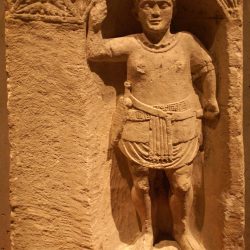Ancient Warfare at the museum - 11
Variety is the spice of life, but ancient tombstones are my wheelhouse, as they say, so here’s another. Anyone with an interest in the ancient Roman army is surely familiar with the famous ‘Rhineland’ series. These are now on display in cities such as Mainz, Worms, Bonn, Cologne, Neuss and Xanten. They all date roughly to AD 25 to 75 and include an uncommonly large number of infantry memorials, belonging both to legionaries and auxiliary soldiers. Compared to other grave markers, they stand out by their size, detail and quality in both the image and inscription. Clearly, there was a ‘studio’ with some very accomplished sculptors. Not everyone employed there was equally good at their job however.
The tombstone depicted here comes from Bonn and is dated to about AD 50-75. From an artistic point of view, it has some issues. The face is rather crude, and the proportions of the limbs seem to be off. Maybe this was a student sculptor, or just someone not as talented as his colleagues. Who knows? The museum unfortunately doesn’t mention in its display whether the stone was found in a known cemetery or somewhere else. That would have answered the puzzle of the missing text. Clearly the stone was meant to include an inscription in the empty field on the left: the decorations at the top cover the area. Perhaps the text was simply painted on, though no trace remains. The obvious alternative would be that the stone was just waiting for someone to buy it and add an inscription later, but was never used.
The depiction of the soldier’s equipment undoubtedly is what interests the readers of Ancient Warfare most. His right hand seems to be supporting a spear of some kind - apart from the pose, light traces of a sculpted shaft are visible above the hand. His left hand might be holding a shield - there seems to be a crossbar and light horizontal lines at about his knee and above shoulder height. Similar depictionsof shields exist on other tombstones from the era. His other armament consists of a pugio, on his right hip, and (heavily damaged) sword on his left. That configuration is normally seen only with standardbearers and centuriones. Is this the exception that confirms the rule? It doesn’t end there though. The crossed double-belt style usually consists of two narrow, decorated belts, sometimes even shown almost parallel. This mix of a broad, decorated belt and plain, narrow belt almost tends towards the later style where the latter changes into the balteus over the shoulder. What is sculpted certainly angles more than the decorated belt, but it doesn’t nearly reach high enough.
Then finally, there’s the clothing and body armour. Our man clearly wears a tunic, hitched up to almost indecent level at the hips, but what goes over that? Are we supposed to recognise pteryges on his upper arms, attached to a jerkin over the tunic? Or is the smooth - apart from the worn ‘Batman-nipples’ upper garment a base to paint lorica hamate on top of?
This stone is full of riddles, but that just makes even a not-very-well executed stone fascinating. Discuss!





